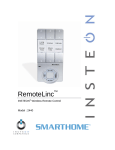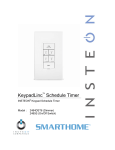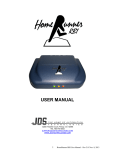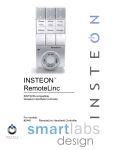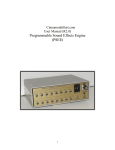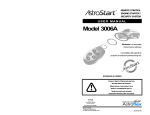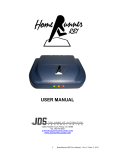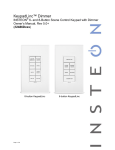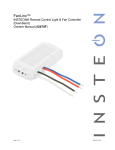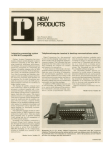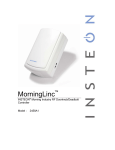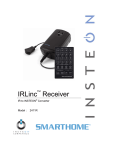Download Smarthome 2457d2 User's Manual
Transcript
LampLinc ™ INSTEON® Plug-In Lamp Dimmer Module, 2-Pin Model : 2457D2 (Dual-Band) 2457D2X (Single-Band) LampLinc Owner’s Manual TABLE OF CONTENTS ABOUT LAMPLINC...................................................................................................................................... 3 Key LampLinc Features............................................................................................................................. 3 What is Included with LampLinc ................................................................................................................ 3 WHAT IS INSTEON?.................................................................................................................................... 4 INSTALLATION............................................................................................................................................ 4 Preparing to Install LampLinc.................................................................................................................... 4 Installing LampLinc.................................................................................................................................... 5 USING LAMPLINC ....................................................................................................................................... 5 Using the Buttons ...................................................................................................................................... 5 Status LED and Beeper Activity ................................................................................................................ 5 ON-LEVELS AND RAMP RATES................................................................................................................ 6 Setting the On-Level.................................................................................................................................. 6 Setting the Ramp Rate .............................................................................................................................. 7 CONTROLLING INSTEON RESPONDERS FROM LAMPLINC ................................................................. 8 Linking LampLinc to an INSTEON Responder.......................................................................................... 8 Unlinking an INSTEON Responder from LampLinc .................................................................................. 8 CONTROLLING LAMPLINC FROM AN INSTEON CONTROLLER ........................................................... 9 Linking an INSTEON Controller to LampLinc............................................................................................ 9 Unlinking LampLinc from an INSTEON Controller .................................................................................... 9 CREATING INSTEON SCENES .................................................................................................................. 9 ADVANCED FEATURES ........................................................................................................................... 10 Using LampLinc as a Phase Bridger (for LampLinc (Dual-Band) only) .................................................. 10 Enabling/Disabling Load Sensing............................................................................................................ 10 Multi-Linking and Multi-Unlinking............................................................................................................. 11 Cross-Linking INSTEON Devices............................................................................................................ 12 Restoring Power to LampLinc ................................................................................................................. 13 Resetting LampLinc to its Factory Default Settings ................................................................................ 13 X10 PROGRAMMING OPTIONS ............................................................................................................... 14 Setting the X10 Address.......................................................................................................................... 14 Removing the X10 Address..................................................................................................................... 14 ABOUT INSTEON ...................................................................................................................................... 15 Using Dual-Band INSTEON Devices to Upgrade Your Network............................................................. 15 Important Note about INSTEON Networks; Split Single-Phase vs. 3-Phase Installation ....................... 15 Further Enhancing Reliability .................................................................................................................. 15 ADDITIONAL RESOURCES ...................................................................................................................... 15 TROUBLESHOOTING................................................................................................................................ 16 SPECIFICATIONS, CERTIFICATION, AND WARRANTY ........................................................................ 18 Specifications .......................................................................................................................................... 18 Certification.............................................................................................................................................. 18 FCC & Industry Canada Compliance Statement..................................................................................... 18 Limited Warranty ..................................................................................................................................... 19 LampLinc Owner’s Manual ABOUT LAMPLINC LampLinc presents you with an elegant and stylish way to dim and remotely control any lamp or other plug-in device in your home at the touch of a button. Send commands to LampLinc from an INSTEON Controller. Or conveniently control other Linked INSTEON devices by using the buttons on the side of LampLinc. The Load Sensing feature can control Linked INSTEON devices by turning the device on and off from its built-in switch. Status LED Outlet Up button Down button Set button Key LampLinc Features Feature Installs and Links to other INSTEON devices in minutes Controls all standard incandescent lamps and other plug-in devices up to 300 Watts Responds to and controls other INSTEON devices as well as X10 devices Indicates INSTEON setup mode activity and operational states with a dual-color Status LED and beeper Dims the load up to 32 brightness levels Changes brightness at 32 Ramp Rates Load Sensing easily disabled and re-enabled Communicates simultaneously over both radio frequency (RF) and the power line Acts as an access point for INSTEON RF-only devices Stores setup state in memory so settings aren’t lost during power outages Two-year warranty 2457D2 (Dual-Band) 2457D2X X X X X X X X X X X X X X X X X X X X X What is Included with LampLinc • LampLinc – INSTEON Plug-In Lamp Dimmer Module (Dual-Band), 2-Pin or LampLinc – INSTEON Plug-In Lamp Dimmer Module, 2-Pin • Quick-Start Guide Page 3 of 19 LampLinc Owner’s Manual WHAT IS INSTEON? Since its inception in 2005, INSTEON has become a best-selling home-control networking technology, offering more reliability and flexibility than any other home management system on the market. INSTEON systems are simple, reliable, and affordable. Simple, because each device takes mere minutes to install. Reliable, because every INSTEON device works as a network repeater, ensuring your commands will not be lost. Affordable, because INSTEON can be integrated into any number of devices easily and at a very low cost. An INSTEON home grows in value with each added INSTEON device, making life more convenient, safe, and fun. How Does INSTEON Work? What makes INSTEON the most reliable home automation network is its dual-mesh network. INSTEON devices use both radio frequency (RF) signals and the home’s existing wiring to talk to each other. In an INSTEON network, every INSTEON device also acts as a repeater, receiving and sending every message to all other devices in the network. So by integrating more INSTEON devices you will strengthen the network and ensure no commands will be lost. No central controller or networking setup is required with an INSTEON network. Simply install your devices and then use a series of button presses or taps to Link your devices together. Throughout this Owner’s Manual, you may see the terms “Controller” or “Responder”. These generic INSTEON terms refer to the components of an INSTEON scene, and are used on a scene-by-scene basis. • Controller – sends INSTEON commands to other devices • Responder – reacts to commands sent out by another INSTEON device An INSTEON device may act as a Controller, Responder, or sometimes both. INSTEON networks are also extremely secure. Each INSTEON device is assigned a unique INSTEON ID, so unless neighbors or would-be hackers have access to your particular device’s INSTEON ID, they won’t be able to control your home, even if they are using similar products. INSTALLATION Preparing to Install LampLinc CAUTION Read and understand these instructions before installing and retain them for future reference. LampLinc is intended for installation in accordance with the National Electric Code and local regulations in the United States or the Canadian Electrical Code and local regulations in Canada. Use indoors only. LampLinc is not designed nor approved for use on power lines other than 120V 60Hz, single phase. Attempting to use LampLinc on non-approved power lines may have hazardous consequences. Prior to installing LampLinc, please review the entire installation procedure and take the following precautions: • Use indoors or in a properly insulated and weatherproof electrical box only • Don’t plug LampLinc into an outlet controlled by a switch because if the switch is inadvertently turned off, LampLinc won’t have power • Don’t plug LampLinc into a filtered power strip or AC line filter • Be sure the device you want to control is working and that the device’s built-in switch is in the on position • If the lamp being controlled by LampLinc already has its own built-in dimmer, turn that dimmer to full-on and allow LampLinc to control the lamp’s brightness • To reduce the risk of overheating and possible damage to other equipment, use LampLinc to control incandescent lamps only. Dimming an inductive load, such as a fan or transformer, could cause damage to the dimmer, the load device, or both. If the manufacturer of the load device does not recommend dimming, use a non-dimming INSTEON ApplianceLinc (#2456S) instead. • Don’t use LampLinc to control devices that preserve, maintain, or contribute to human or animal safety or life support If you have any questions, please call: INSTEON Gold Support Line 800-762-7845 Page 4 of 19 LampLinc Owner’s Manual Installing LampLinc 1) Plug the lamp/device (the load) you want to control into the outlet on LampLinc 2) Plug LampLinc into an unswitched wall outlet The load may turn on If the LampLinc Status LED is solid green, installation is complete If the Status LED is solid red, tap the Up button The LampLinc Status LED will turn on solid green and the load will turn on 3) If the load does not turn on, turn it on manually using the switch on the load itself NOTE: After completing installation, you will not be able to use the load’s built-in switch to control the load unless Load Sensing is enabled. See Enabling/Disabling Load Sensing. USING LAMPLINC Using the Buttons The LampLinc buttons will control the load and any Linked Responders. LampLinc or the Responders will behave differently depending on whether you tap, double-tap, or hold down the buttons. Button Tap Ramp to On-Level Ramp to Off Up Down Double-tap Full-bright instantly Full-off instantly Press & hold Brighten until released Dim until released Status LED and Beeper Activity Status LED Activity Status LED Activity Solid green Solid red LampLinc Status/Setup Mode Load is on Phase Bridging Detection Mode has been initiated Load is off Linking Mode Blinking green Phases have been bridged (if used as a secondary device during Phase Bridging Detection Mode) Blinking red Unlinking Mode Double-blinking green Multi-Linking Mode Double-blinking red Multi-Unlinking Mode Tapping the Set Button If LampLinc is in a setup mode, tap the Set button to exit the setup mode and return to normal operation. Beeper Activity Beeper Activity LampLinc Status Entered setup mode or moved to the subsequent setup mode Single beep Exited setup mode (if Set button was tapped) Feature was programmed (e.g., On-Level, Ramp Rate) Double beep Link established – LampLinc will exit setup mode Long beep Timed out of setup mode Continuous beep (once per second) Initiated Phase Bridging Detection Mode Page 5 of 19 LampLinc Owner’s Manual ON-LEVELS AND RAMP RATES The On-Level is the brightness that the load will go to when you turn it on. The On-Level is adjustable from off to 100% brightness. The default is 100%. The Ramp Rate is the amount of time it will take the load to go from full-off to full-on or from full-on to fulloff. The Ramp Rate is adjustable from 0.1 to 9 seconds to ramp between full-on and full-off and vice versa. The default is 0.1 seconds. You can set up a local On-Level/Ramp Rate, which is activated by tapping the buttons on LampLinc. Or set up remote On-Levels/Ramp Rates that are activated when you tap an On/Off or Scene button on a Linked Controller. A single LampLinc is capable of storing different On-Levels and Ramp Rates for each Linked Controller (or each button if it is a multi-scene Controller). On-Levels and Ramp Rates are locked in separately and can be set up in any order. When you do the lock-in, the most recently set On-Level and Ramp Rate are locked in together. Setting the On-Level 1) Use the Up and Down buttons on LampLinc to adjust the load to the desired brightness 2) Once the desired brightness has been achieved, tap the Set button on LampLinc LampLinc will beep and the load will flash once 3) Test the On-Level setting by tapping the Up and Down buttons on LampLinc LampLinc will respond appropriately The local On-Level has now been set. If you would like to set up a Controller to set LampLinc to the programmed On-Level, proceed to Linking an INSTEON Controller to LampLinc and begin from step 2. NOTE: If LampLinc is blinking its Status LED, you held the Set button down too long. Holding down the Set button for 3 seconds is an alternate way to place LampLinc into Linking Mode. Linking Mode will time out after 4 minutes of inactivity. To manually exit Linking Mode, tap the Up or Down button. Page 6 of 19 LampLinc Owner’s Manual Setting the Ramp Rate NOTE: Setting the Ramp Rate does not change/affect the On-Level brightness. 1) Setting the Ramp Rate is done using the brightness level as an indicator for how fast LampLinc should ramp. Use the Up and Down buttons on LampLinc to set the brightness to a brighter level for a faster Ramp Rate or dimmer for a slower Ramp Rate. 100% corresponds to a 0.1-second Ramp Rate and full-off corresponds to a 9-second Ramp Rate. The following table gives the approximate relationship between the brightness you set in this step and the Ramp Rate you get. Approximate Brightness Level Ramp Rate in seconds 90-100% 0.1 77-87% 0.2 65-74% 0.3 52-61% 0.5 39-48% 2.0 26.35% 4.5 13-23% 6.5 1-10% 8.5 Less than 1% 9.0 NOTE: If the load is ramping to less than full brightness, then the time it will take will be proportionately less. For instance, if the load is going to halfbrightness, the time it will take for a given Ramp Rate will be halved. 2) Once you reach the desired brightness (Ramp Rate), double-tap the Set button on LampLinc LampLinc will beep and the load will flash once 3) Test the Ramp Rate settings by tapping the Up and Down buttons on LampLinc LampLinc will respond appropriately The local Ramp Rate has now been set. If you would like to set up a Controller to set LampLinc to the programmed Ramp Rate, proceed to Linking an INSTEON Controller to LampLinc. NOTE: If the load flashes twice or you heard two beeps, you didn’t double-press the Set button fast enough and the On-Level was actually set up twice. Reset the correct On-Level and try setting the Ramp Rate again from step 1. Page 7 of 19 LampLinc Owner’s Manual CONTROLLING INSTEON RESPONDERS FROM LAMPLINC Linking LampLinc to an INSTEON Responder To use LampLinc as an INSTEON Controller, follow these steps to Link LampLinc and an INSTEON Responder (the device you wish to control with LampLinc) together. Refer to the Responder’s Owner’s Manual for detailed instructions on how to properly install and Link it to LampLinc. The following will work for the most common INSTEON devices: 1) At the Responder, set it to the state you wish to be activated from LampLinc (turn it on if you wish it to be on or off if you wish it to be off when LampLinc activates the scene, set On-Levels, etc.) • If the Responder is a multi-scene device, tap the Scene button you wish to control until its LED is in the desired state (on or off) 2) Set LampLinc to Linking Mode by pressing & holding the Set button until it beeps (3 seconds) The LampLinc Status LED will begin blinking green and the load will flash once You will have 4 minutes to complete the next step before Linking Mode automatically times out. BE CAREFUL - Any accidental button presses will exit Linking Mode early. 3) Press & hold the Responder's Set button for 3 seconds LampLinc will double-beep and its Status LED will stop blinking and turn solid green if the load is on or solid red if it is off The load will flash twice 4) Confirm that Linking was successful by tapping the Up and Down buttons on LampLinc The Responder will respond appropriately 5) If you wish to Link multiple Responders to the same LampLinc, either repeat steps 1-4 with each Responder or see Multi-Linking and Multi-Unlinking Unlinking an INSTEON Responder from LampLinc If you are no longer going to use an INSTEON Responder that has been Linked to LampLinc, it is very important that you Unlink it. Otherwise, LampLinc will retry any commands repetitively, thus slowing down the system. The following will work for the most common INSTEON devices: 1) If the Responder is a multi-scene device, tap the Scene button you wish to remove control from until its LED illuminates 2) Set LampLinc to Linking Mode by pressing & holding the Set button until it beeps (3 seconds) The LampLinc Status LED will begin blinking green and the load will flash once 3) Set LampLinc to Unlinking Mode by pressing & holding the Set button until it beeps again (3 seconds) The LampLinc Status LED will begin blinking red and the load will flash once You will have 4 minutes to complete the next step before Unlinking Mode automatically times out. 4) Press & hold the Responder’s Set button for 3 seconds LampLinc will double-beep and its Status LED will stop blinking and turn on solid green if the load is on or solid red if it is off The load will flash twice 5) Confirm that Unlinking was successful by tapping the Up and Down buttons on LampLinc The Responder will respond appropriately Page 8 of 19 LampLinc Owner’s Manual CONTROLLING LAMPLINC FROM AN INSTEON CONTROLLER Linking an INSTEON Controller to LampLinc To use LampLinc as an INSTEON Responder, follow these steps to Link LampLinc and a Controller together. Refer to the Controller’s Owner’s Manual for detailed instructions on how to properly install and Link it to LampLinc. The following will work for the most common INSTEON devices: 1) Use the Up and Down buttons to adjust the load to the desired brightness level 2) Set the Controller to Linking Mode. (For most Controllers, press & hold an On or Scene button for 10 seconds or the Set button for 3 seconds.) You will have 4 minutes to complete the next step before Linking Mode automatically times out. 3) Press & hold the Set button on LampLinc until it double-beeps (3 seconds) The LampLinc Status LED will flash once and then turn on solid green if the load is on or solid red if it is off The load will flash twice 4) Confirm that Linking was successfully by tapping the button you just Linked to on the Controller LampLinc will respond appropriately Unlinking LampLinc from an INSTEON Controller If you are going to discontinue using LampLinc, it is very important that you Unlink it from any Linked Controllers. Otherwise, the Controllers will retry any commands repetitively, thus slowing down the system. The following will work for the most common INSTEON devices: 1) Set the Controller to Unlinking Mode. (For most Controllers, press & hold an On or Scene button for 10 seconds twice or the Set button for 3 seconds twice.) You will have 4 minutes to complete the next step before Unlinking Mode automatically times out. 2) Press & hold the Set button on LampLinc until it double-beeps (3 seconds) The LampLinc Status LED will flash once and then turn on solid green if the load is on or solid red if it is off The load will flash twice 3) Confirm that Unlinking was successful by tapping the button you just Unlinked from on the Controller LampLinc will respond appropriately CREATING INSTEON SCENES INSTEON scenes let you activate dramatic lighting moods with the tap of just one button. For example, you can set all the lights in a scene to dim to 50% or turn certain lights on while turning others off, all with the tap of a button on a Controller. INSTEON scenes are very easy to set up – just Link more than one Responder to the same On/Off or Scene button on a Controller. Then, when you tap any of the Linked buttons on the Controller, all of the INSTEON devices Linked in the scene will respond as a group. To set up an INSTEON scene, you can individually Link each device to a Controller. Or save time and create multiple Links at once (see Multi-Linking and Multi-Unlinking). Page 9 of 19 LampLinc Owner’s Manual ADVANCED FEATURES Using LampLinc as a Phase Bridger (for LampLinc (Dual-Band) only) Use the following procedure to test that the phases have been bridged: 1) Install additional dual-band INSTEON devices if they aren’t already installed 2) Start Phase Bridging Detection Mode by tapping the Set button on LampLinc four times quickly LampLinc will begin beeping continuously and the Status LED will be solid green Depending on its current state, the load may turn on or flash once Phase Bridging Detection Mode will time out after 4 minutes of inactivity. 3) Check the LED behavior of your other dual-band devices to see if they are on the opposite phase If at least one of your other dual-band device LEDs is blinking green or is bright solid white or blue, the device is on the opposite phase. Continue to step 4. If none of your dual-band devices exhibit the behavior above, they are on the same electrical phase. Try one or both of the following: 4) • Move a dual-band device to another location until it exhibits the desired behavior • Follow steps 2 and 3 with your other dual-band devices to see if they are bridging the phases Tap the Set button on LampLinc to exit Phase Bridging Detection Mode LampLinc will stop beeping and the Status LED will remain solid green if the load is on or turn solid red if it is off Enabling/Disabling Load Sensing Load Sensing allows you to manually turn on the load plugged into LampLinc by using the switch on the load itself, without sending a command from an INSTEON or X10 controller. When the load is in the off state (with Load Sensing enabled), LampLinc will “sense” that you are trying to turn it on with its built-in switch. When LampLinc senses this, it will turn on the load automatically. If LampLinc is used to control other INSTEON devices, those devices will also respond appropriately when the load is turned on with its built-in switch. CAUTION: With Load Sensing enabled, some lamps have been known to turn on LampLinc after you have turned it off. Please use this feature with caution. By default, Load Sensing is enabled on LampLinc. Disable Load Sensing 1) Press & hold the Set button on LampLinc until it beeps (3 seconds) The LampLinc Status LED will begin blinking green 2) Double-tap the Set button on LampLinc LampLinc will beep and its Status LED will stop blinking and turn on solid green if the load is on or solid red if it is off 3) Test that Load Sensing has been disabled by turning the load on and off from its built-in switch The load will not respond Enable Load Sensing 1) Press & hold the Set button on LampLinc until it beeps (3 seconds) The LampLinc Status LED will begin blinking green 2) Triple-tap the Set button on LampLinc LampLinc will beep and its Status LED will stop blinking and turn on solid green if the load is on or solid red if it is off 3) Test that Load Sensing has been enabled by turning the load on and off from its built-in switch The load will turn on and off Page 10 of 19 LampLinc Owner’s Manual Multi-Linking and Multi-Unlinking Multi-Linking Multi-Linking Mode allows you to Link multiple Responders to a single Controller and quickly create an INSTEON scene. Once the Controller is in Multi-Linking Mode, you can Link any number of Responders, one right after the other. The following will work for the most common INSTEON devices: 1) Set each of the Responders to the state you wish to activate from the Controller • Turn the Responder on or off, set the brightness/On-Level and Ramp Rate, etc. • If the Responder is a multi-scene device (e.g., KeypadLinc), tap the desired Scene button until its LED is in the desired state (on or off) 2) Set the Controller to Linking Mode. (For most Controllers, press & hold the desired On or Scene button for 10 seconds or the Set button for 3 seconds.) 3) Tap the Set button on the Controller. If the Controller does not have a Set button, tap the same On or Scene button you used to put the Controller into Linking Mode. Multi-Linking Mode will automatically time out after 4 minutes of inactivity. 4) One at a time, press & hold each of the Responder’s Set buttons for 3 seconds 5) After you have Linked all the desired Responders, tap the Controller’s Set button to exit Multi-Linking Mode. If the Controller does not have a Set button, tap the same On or Scene button you used to put the Controller into Linking Mode. 6) Test that the INSTEON scene is working properly by tapping the button you just Linked to on the Controller Multi-Unlinking Multi-Unlinking Mode can be used to quickly remove devices from an INSTEON scene. You may remove as many of the Linked Responders from the scene as you would like. The following will work for the most common INSTEON devices: 1) Set the Controller to Unlinking Mode. (For most Controllers, press & hold the desired On or Scene button for 10 seconds twice or the Set button for 3 seconds twice.) 2) Tap the Set button on the Controller. If the Controller does not have a Set button, tap the same On or Scene button you used to put the Controller into Unlinking Mode. Multi-Unlinking Mode will automatically time out after 4 minutes of inactivity. 3) For each of the Responders you wish to Unlink, press & hold the Set button for 3 seconds. (If the Responder is a multi-scene device, tap the Scene button you wish to Unlink and then press & hold the Set button.) 4) After you have Unlinked the desired Responders, tap the Controller’s Set button to exit MultiUnlinking Mode. If the Controller does not have a Set button, tap the same On or Scene button you used to put the Controller into Unlinking Mode. 5) Test that you have removed the desired Responders from the INSTEON scene by tapping the button you just Unlinked from on the Controller Page 11 of 19 LampLinc Owner’s Manual Cross-Linking INSTEON Devices Cross-Linking Two INSTEON Devices Cross-Linking devices allow you to track the on/off status of the load on all Linked INSTEON Responders. For this example we will use a primary device controlling the load and one secondary device in a virtual 3-way. They will be referred to as: the Primary Device (the device wired to the load or load-controlling) and the Secondary Device (the additional device in the circuit). 1) Link the Primary Device as a Controller of the Secondary Device: a) Set the Secondary Device to the desired state (i.e., on/off, set Ramp Rate and OnLevel/brightness level) b) Put the Primary Device into Linking Mode. (For most devices, press & hold an On or Scene button for 10 seconds or the Set button for 3 seconds.) c) Press & hold the Set button on the Secondary Device for 3 seconds • 2) If the Secondary Device is a multi-scene device (e.g., KeypadLinc), tap the Scene button you wish to control until its LED illuminates and then press & hold the Set button for 3 seconds Cross-Link the Secondary Device as a Controller of the Primary Device: a) Set the Primary Device to the desired state (i.e., on/off, set Ramp Rate and On-Level/brightness level) b) Put the Secondary Device into Linking Mode. (For most devices, press & hold an On or Scene button for 10 seconds or the Set button for 3 seconds.) c) Press & hold the Set button on the Primary Device for 3 seconds • If the Primary Device is a multi-scene device, tap the Scene button you wish to control until its LED illuminates and then press & hold the Set button for 3 seconds Upon successful completion, each device will now track the on/off status of the load (and the LEDs of the devices it has been Cross-Linked to). Cross-Linking More Than Two INSTEON Devices When you have more than two devices controlling a single load, you can the Multi-Linking feature to Link one device to multiple others in one step. To Cross-Link all the devices together, you will perform a series of MultiLinking circuits. For this example, we will use a primary device controlling the load and two secondary switches in a virtual 4way. They will be referred to as: the Primary Device (load-controlling), the Secondary Device 1, and the Secondary Device 2. 1) Start the circuit by setting the Primary Device to Linking Mode. (For most devices, press & hold an On or Scene button for 10 seconds or the Set button for 3 seconds.) 2) Tap the Set button on the Primary Device to set it to Multi-Linking Mode. If the Primary Device does not have a Set button, use the same On or Scene button you used to put the Primary Device into Linking Mode. 3) One at a time, press & hold the Set buttons on each of the Secondary Devices for 3 seconds 4) To finish the circuit, tap the Set button on the Primary Device. If the Primary Device does not have a Set button, use the same On or Scene button you used to put the Primary Device into Linking Mode. 5) Create the next circuit by repeating steps 1-4, substituting the Secondary Device 1 for the Primary Device 6) Create the next circuit by repeating steps 1-4, substituting the Secondary Device 2 for the Primary Device Upon successful completion, each device in the above scenario will now track the on/off status on the load (and the LEDs of the devices it has been Cross-Linked to). Page 12 of 19 LampLinc Owner’s Manual Restoring Power to LampLinc LampLinc stores all of its settings, such as Links to other INSTEON devices, On-Levels/Ramp Rates, etc., with non-volatile memory. Because settings are saved in this non-volatile memory, they will not be lost in the event of a power failure. In the event of a power loss LampLinc will automatically return the load to the brightness level it had before power was interrupted. Resetting LampLinc to its Factory Default Settings The factory reset procedure can be used to clear the LampLinc memory of all INSTEON Links, programmed On-Levels and Ramp Rates, X10 addresses, etc. 1) If you are using a Controller to control LampLinc, be sure to Unlink it from the Controller. See Unlinking LampLinc from an INSTEON Controller. 2) If you are using LampLinc to control any Responders, Unlink them from LampLinc. See Unlinking an INSTEON Responder from LampLinc. 3) Unplug LampLinc for about 10 seconds 4) While holding down the Set button, plug LampLinc back in, making sure not to let go of the Set button LampLinc will beep and its Status LED will turn on solid green 5) Continue to hold down the Set button for 3 seconds and then release LampLinc will double-beep and the load will turn on Page 13 of 19 LampLinc Owner’s Manual X10 PROGRAMMING OPTIONS LampLinc is X10 ready, meaning that it can respond to X10 commands from X10 controllers and send commands to X10 devices. However, to operate LampLinc in X10 mode, you must first set up an X10 address. As it ships from the factory or after a factory reset procedure, LampLinc will not have an X10 address set up. Setting the X10 Address 1) Set LampLinc to Linking Mode by pressing & holding the Set button until it beeps (3 seconds) The LampLinc Status LED will begin blinking green The load will flash once You will have 4 minutes to complete the next step before Linking Mode automatically times out. 2) Using an X10 controller, send the X10 address you want to assign and the ON command three times For example, to assign the address A1, you would send “A1 ON A1 ON A1 ON.” 3) Once LampLinc has received the sequence, it will exit Linking Mode LampLinc will beep and its Status LED will turn on solid green if the load is on or solid red if it is off Removing the X10 Address If you are no longer going to control LampLinc with an X10 address, it is very important that you Unlink it. Otherwise, LampLinc will still respond to X10 commands and may cause LampLinc to turn on by itself. 1) Set LampLinc to Linking Mode by pressing & holding the Set button until it beeps (3 seconds) The LampLinc Status LED will begin blinking green The load will flash once 2) Set LampLinc to Unlinking Mode by pressing & holding the Set button until it beeps again (3 seconds) The LampLinc Status LED will begin blinking red The load will flash once You will have 4 minutes to complete the next step before Unlinking Mode automatically times out. 3) Using an X10 controller, send the X10 address you wish to remove and the ON command three times For example, to remove the address A1, you would send “A1 ON A1 ON A1 ON”. 4) Once LampLinc has received the sequence, it will exit Linking Mode LampLinc will beep and its Status LED will turn on solid green if the load is on or solid red if it is off Page 14 of 19 LampLinc Owner’s Manual ABOUT INSTEON Using Dual-Band INSTEON Devices to Upgrade Your Network What are phases? The majority of single-family homes in North America have two phases (or “legs”) of 110 Volts coming into their electricity panels. From the panel, they are distributed throughout the home, providing power to outlets and wall switches. These phases come together in some parts of the home to provide 220 Volts of power to large appliances, such as an electric oven or pool pump. Why do I need to bridge these phases? Single-band power line devices send commands via the home’s electricity, but only on a single phase. If the command is intended for a device on the opposite phase, there is a good chance the command will go unnoticed. Installing dual-band INSTEON devices, such as Access Points (#2443), on each phase will allow for devices to communicate between the two phases via RF. Dual-band INSTEON devices embody the full potential of a true INSTEON mesh network. Taking the power line band signal and working in conjunction with the RF band signal, its dual-band function plays out in two ways: • Phase bridger – a receiver of commands, reacting to and translating signals sent from one power phase to the opposite via RF • Signal repeater – a participant in an INSTEON network, repeating commands intended for other devices whether those commands are generated from RF or power line-only devices. To ensure reliability, every INSTEON device confirms that it has received a command. If a Controller does not receive this confirmation, it will automatically retransmit the command up to five times. While using at least one dual-band device is required when using an RF-only device, at least two dual-band devices are recommended in any INSTEON network to ensure reliable communication across two-phase home wiring systems. For larger applications, it is recommended to install at least one dual-band device for every 750 – 1,000 square feet. Search for dual-band INSTEON devices at: www.smarthome.com/dualband Important Note about INSTEON Networks; Split Single-Phase vs. 3-Phase Installation For the best INSTEON network performance, be sure you have properly installed at least two dual-band INSTEON devices. INSTEON has only been officially tested in a split single-phase residential environment but has been known to work in many 3-phase systems, where three dual-band devices are used (one on each phase). However, due to the potential complexity of its troubleshooting, the INSTEON Gold Support Line is unable to support INSTEON in 3-phase environments. Further Enhancing Reliability As signals travel via the power line or RF throughout the home, they naturally become weaker the farther they travel. The best way to overcome weakened signals is to increase the coverage of the mesh network by introducing more INSTEON devices. It is possible that some audio-video devices, computers, power strips, or other electrical equipment may attenuate INSTEON signals on the power line. You can temporarily unplug suspected devices to test whether the INSTEON signal improves. If it does, then you can plug in filters that will permanently fix the problem. ADDITIONAL RESOURCES Find home automation solutions, helpful tips, interactive demos, videos, user forums, and more at the Smarthome Learning Center: www.smarthome.com/learningcenter.html Page 15 of 19 LampLinc Owner’s Manual TROUBLESHOOTING Problem The Status LED on LampLinc is not turning on and won’t control the load. Possible Cause LampLinc may not be getting power. The Controller or Responder might have been reset without Unlinking LampLinc from it. The Controller or Responder and LampLinc may be on opposite power line phases. LampLinc won’t Link or work with a Controller or Responder. The INSTEON signal may be too weak. Solution Make sure LampLinc is not plugged into a switched outlet that is turned off. Re-Link LampLinc to the Controller or Responder. Make sure two dual-band INSTEON devices are properly installed to bridge the two power line phases. Add additional INSTEON devices or move around existing INSTEON devices. All INSTEON devices act as INSTEON network repeaters. Large appliances, such as refrigerators or air conditioners, may be producing electrical noise on the power line. Install a power line noise filter (#1626-10) to filter electrical noise and minimize signal attenuation. Other electrical devices, such as computers, televisions, or power strips, may be absorbing the INSTEON signal. Unlink any unused Responders from the The Controller may be Controller. sending commands to a HINT: If you are using home automation software, Responder that is no LampLinc is taking a longer in use. Commands you can easily check scene membership and long time to respond to a Controller. for the unused Responder eliminate unnecessary Links. are being resent and If the above doesn’t work, perform a factory reset loading down the signal. on the Controller. LampLinc may be sending Unlink any unused Responders from LampLinc. HINT: If you are using home automation software, commands to a you can easily check scene membership and Responders are taking Responder that is no a long time to respond longer in use. Commands eliminate unnecessary Links. to LampLinc. for the unused Responder If the above doesn’t work, perform a factory reset are being resent and on LampLinc. See Resetting LampLinc to its loading down the signal. Factory Default Settings. Another Controller, a The load turned on by timer, or stray X10 signals Perform a factory reset on LampLinc. See itself. could have triggered Resetting LampLinc to its Factory Default Settings. LampLinc. Page 16 of 19 LampLinc Owner’s Manual Problem LampLinc can turn off a Responder, but nothing happens when I send an ON command from LampLinc. The Controller can turn off LampLinc, but LampLinc does not turn on when I send an ON command from the Controller. The load is buzzing when on or dim. The load only turns off when I tap a button on the Controller but I can brighten or dim it. The load doesn’t appear to turn on right away. LampLinc is locked up. Possible Cause Solution The Responder may be Linked at its off state. Re-Link the Responder to LampLinc, while the Responder’s load is on. See the Responder’s Owner’s Manual for more detailed Linking instructions. LampLinc may be Linked at its off state. Re-Link LampLinc to the Controller, while the load is on. See Linking an INSTEON Controller to LampLinc. The dimming component inside LampLinc “chops” the power line sine wave to reduce the power. The bulb filaments are vibrating. Use roughservice, 130 Volt, or appliance-grade bulbs to reduce the noise. Run LampLinc in the full-on mode or switch to a non-dimming INSTEON ApplianceLinc (#2456S). The On-Level may be set to very dim or fully-off. Re-Link LampLinc to the Controller at a brighter On-Level. See Linking an INSTEON Controller to LampLinc. The Ramp Rate may be set too slow. Set a shorter Ramp Rate. See Setting the Ramp Rate. A surge or excessive noise on the power line may have glitched it. Unplug LampLinc for 10 seconds and then reinstall. If the above doesn’t work, perform a factory reset. See Resetting LampLinc to its Factory Default Settings. The lamp does not The Load Sensing feature Re-enable the Load Sensing feature. See turn on when I manually activate the may have been disabled Enabling/Disabling Load Sensing. lamp’s switch. The load is not being The load may not be Make sure the load’s built-in switch is in the on controlled by getting power. position. LampLinc. If you have tried these solutions, reviewed this Owner’s Manual, and still cannot resolve an issue you are having with LampLinc, please call: INSTEON Gold Support Line 800-762-7845 Page 17 of 19 LampLinc Owner’s Manual SPECIFICATIONS, CERTIFICATION, AND WARRANTY Specifications View specifications for LampLinc – INSTEON Plug-In Lamp Dimmer Module (Dual-Band) (#2457D2) at: www.smarthome.com/2457D2.html View specifications for LampLinc – INSTEON Plug-In Lamp Dimmer Module (#2457D2X) at: www.smarthome.com/2457D2X.html Certification This product has been thoroughly tested by ITS ETL SEMKO, a nationally recognized independent thirdparty testing laboratory. The North American ETL Listed mark signifies that the device has been tested to and has met the requirements of a widely recognized consensus of U.S. and Canadian device safety standards, that the manufacturing site has been audited, and that the manufacturer has agreed to a program of quarterly factory follow-up inspections to verify continued conformance. FCC & Industry Canada Compliance Statement This device complies with FCC Rules Part 15 and Industry Canada RSS-210 (Rev. 7). Operation is subject to the following two conditions: (1) This device may not cause harmful interference, and (2) This device must accept any interference, including interference that may cause undesired operation of the device. Le present appareil est conforme aux CNR d'Industrie Canada applicables aux appareils radio exempts de licence. L'exploitation est autorise aux deux conditions suivantes: (1) l'appareil ne doit pas produire de brouillage, et (2) l'utilisateur de l'appareil doit accepter tout brouillage radiolectrique subi, mme si le brouillage est susceptible d'en compromettre le fonctionnement. The digital circuitry of this device has been tested and found to comply with the limits for a Class B digital device, pursuant to Part 15 of the FCC Rules. These limits are designed to provide reasonable protection against harmful interference in residential installations. This equipment generates, uses, and can radiate radio frequency energy and, if not installed and used in accordance with the instructions, may cause harmful interference to radio and television reception. However, there is no guarantee that interference will not occur in a particular installation. If this device does cause such interference, which can be verified by turning the device off and on, the user is encouraged to eliminate the interference by one or more of the following measures: • Re-orient or relocate the receiving antenna of the device experiencing the interference • Increase the distance between this device and the receiver • Connect the device to an AC outlet on a circuit different from the one that supplies power to the receiver • Consult the dealer or an experienced radio/TV technician WARNING: Changes or modifications to this device not expressly approved by the party responsible for compliance could void the user’s authority to operate the equipment. Page 18 of 19 LampLinc Owner’s Manual Limited Warranty Seller warrants to the original consumer purchaser of this product that, for a period of two years from the date of purchase, this product will be free from defects in material and workmanship and will perform in substantial conformity to the description of the product in this Owner’s Manual. This warranty shall not apply to defects or errors caused by misuse or neglect. If the product is found to be defective in material or workmanship, or if the product does not perform as warranted above during the warranty period, Seller will either repair it, replace it, or refund the purchase price, at its option, upon receipt of the product at the address below, postage prepaid, with proof of the date of purchase and an explanation of the defect or error. The repair, replacement, or refund that is provided for above shall be the full extent of Seller’s liability with respect to this product. For repair or replacement during the warranty period, call the INSTEON Gold Support Line at 800-762-7845 with the Model # and Revision # of the device to receive an RMA# and send the product, along with all other required materials to: Smarthome, Inc. ATTN: Receiving Dept. 16542 Millikan Ave. Irvine, CA 92606-5027 Limitations The above warranty is in lieu of and Seller disclaims all other warranties, whether oral or written, express or implied, including any warranty or merchantability or fitness for a particular purpose. Any implied warranty, including any warranty of merchantability or fitness for a particular purpose, which may not be disclaimed or supplanted as provided above shall be limited to the two-year of the express warranty above. No other representation or claim of any nature by any person shall be binding upon Seller or modify the terms of the above warranty and disclaimer. Home automation devices have the risk of failure to operate, incorrect operation, or electrical or mechanical tampering. For optimal use, manually verify the device state. Any home automation device should be viewed as a convenience, but not as a sole method for controlling your home. In no event shall Seller be liable for special, incidental, consequential, or other damages resulting from possession or use of this device, including without limitation damage to property and, to the extent permitted by law, personal injury, even if Seller knew or should have known of the possibility of such damages. Some states do not allow limitations on how long an implied warranty lasts and/or the exclusion or limitation of damages, in which case the above limitations and/or exclusions may not apply to you. You may also have other legal rights that may vary from state to state. INSTEON Technology Patent U.S Patent No. 7,345,998, International patents pending © Copyright 2011 Smarthome, 16542 Millikan Ave., Irvine, CA 92606, 800-762-7845, www.smarthome.com Rev 05-02-2011 Page 19 of 19
























